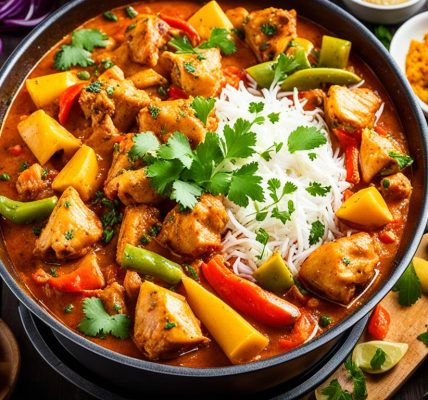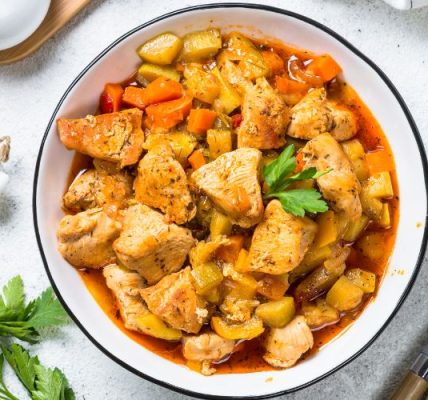This easy Thai green chicken curry recipe is a quick and tasty way to bring the authentic flavors of Thailand into your home. With simple and readily available ingredients, you can make a delicious homemade green curry that is sure to impress. Follow this recipe to create a flavorful and satisfying dish that can be enjoyed by the whole family.
Ingredients for Thai Green Chicken Curry Recipe
To make this Thai green chicken curry, you will need the following ingredients:
- Thai basil
- Bamboo shoots (or substitutes like Thai eggplant or winter melon)
- Red bell pepper
- Green curry paste (store-bought or homemade)
- Coconut milk
- Fish sauce
- Palm sugar
- Chicken thighs
- Chicken stock
These ingredients are easily accessible and can be found in most grocery stores. Adjustments can be made based on personal preferences and dietary restrictions.
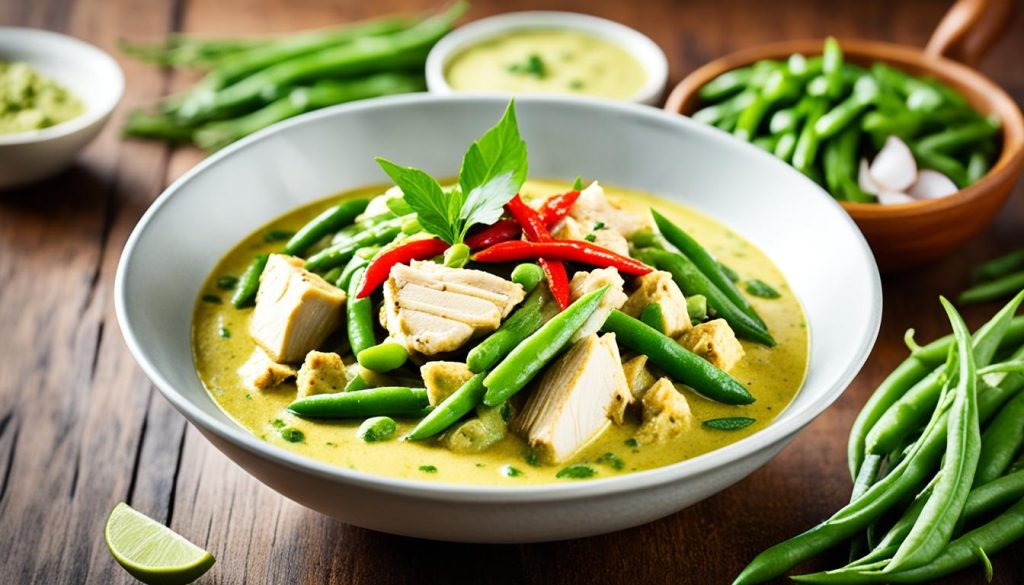
Steps to Make Thai Green Chicken Curry
Follow these steps to create a delicious Thai green chicken curry:
- Optional step: Pound the green curry paste and Thai basil leaves for a vibrant color.
- Reduce the coconut milk until thick.
- Sauté the curry paste for a few minutes.
- Toss the chicken with the curry paste.
- Add the coconut milk and chicken stock.
- Add the makrut lime leaves, fish sauce, and palm sugar.
- Simmer the curry until the chicken is tender.
- Add the bamboo shoots and cook for a minute.
- Stir in the red bell pepper and turn off the heat.
- Add the Thai basil and stir until wilted. Your Thai green chicken curry is now ready to be served with jasmine rice.
Tips for Perfecting Your Green Curry
- For a more intense flavor, pound the green curry paste and Thai basil leaves in a mortar and pestle. This releases their oils and enhances the overall taste of the dish.
- When reducing the coconut milk, keep a close eye on it to prevent it from burning. Stir occasionally to ensure even thickness.
- Sautéing the curry paste brings out its aromatic flavors. Cook it for a few minutes until fragrant before adding the chicken.
- Coat the chicken thoroughly with the curry paste for even distribution of flavors throughout the dish.
- Simmer the curry until the chicken is fork-tender to ensure tender and succulent meat.
- Feel free to adjust the amount of fish sauce and palm sugar according to your taste preferences. Start with a smaller amount and add more if desired.
- Adding the bamboo shoots and red bell pepper towards the end of cooking retains their crispness and vibrant colors.
- The Thai basil leaves should be added at the very end to preserve their fresh aroma and prevent them from wilting too much.
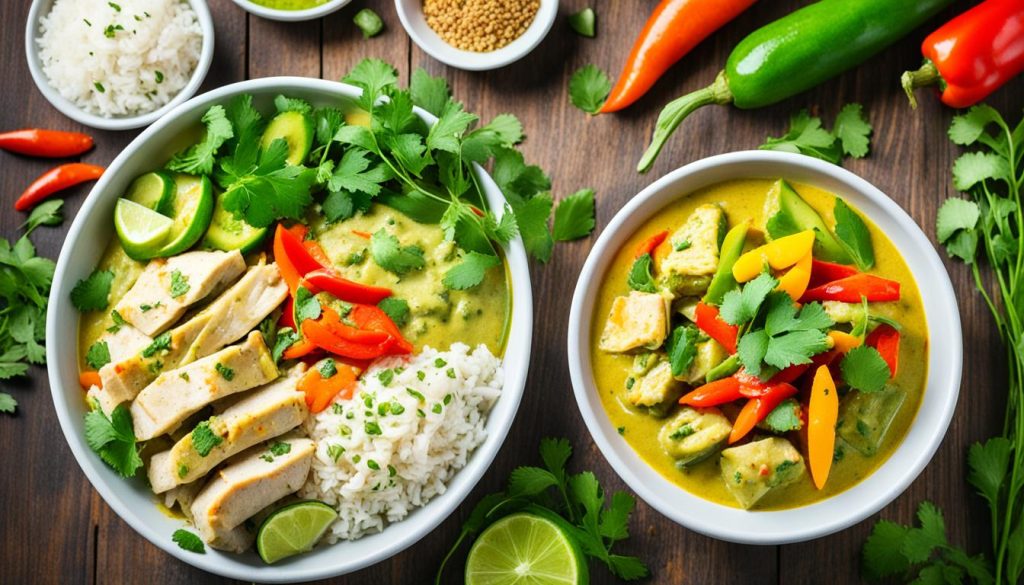
| Ingredient | Quantity |
|---|---|
| Pound Green Curry Paste | 2 tablespoons |
| Coconut Milk | 1 can |
| Chicken Stock | 1/2 cup |
| Makrut Lime Leaves | 3 leaves |
| Fish Sauce | 2 tablespoons |
| Palm Sugar | 1 tablespoon |
| Bamboo Shoots | 1/2 cup |
| Red Bell Pepper | 1 |
| Thai Basil | A handful |
Vegan Modifications for Thai Green Curry
This Thai green curry recipe can easily be made vegan by making a few modifications:
- Use any vegan protein of your choice, such as tofu or chickpeas.
- If using tofu, medium-firm tofu or fried tofu made for soup works well.
- For an all-veggie green curry, omit the protein and focus on hearty vegetables like Asian mushrooms and Japanese eggplant.
- Replace fish sauce with soy sauce, salt, or vegan fish sauce.
- Use vegetable broth instead of chicken stock. Alternatively, you can use dried shiitake soaking water for added flavor.
To add a vegan protein to your green curry, tofu is a fantastic option. Choose medium-firm tofu or fried tofu made specifically for soups as they hold their shape well in the curry. If you prefer an all-veggie green curry, skip the protein altogether and load up on delicious and hearty vegetables such as Asian mushrooms and Japanese eggplant.
Another key modification is replacing the fish sauce. Instead, use soy sauce, salt, or a vegan fish sauce alternative for the umami flavor. Additionally, switch out the chicken stock with vegetable broth to maintain the depth of flavor. If you want to add an extra layer of complexity to your curry, consider using the soaking water from dried shiitake mushrooms.
With these simple adjustments, you can create a delicious vegan green curry that satisfies both your taste buds and your dietary preferences.
The Heat Level of Green Curry
The heat level of green curry can vary depending on the curry paste used and the amount of curry paste added. In general, store-bought green curry paste tends to be hotter than red curry paste. Both green and red curry pastes are typically hotter than yellow, panang, and massaman curry pastes. However, it is important to note that the heat level can be adjusted based on personal preferences. If a milder curry is desired, less curry paste can be used or milder brands can be chosen.
Comparing the Heat Levels of Different Curries
To better understand the heat level of green curry, let’s compare it to other popular Thai curries:
| Curry Type | Heat Level |
|---|---|
| Green Curry | Hotter |
| Red Curry | Hot |
| Yellow Curry | Mild |
| Panang Curry | Mild to Moderate |
| Massaman Curry | Mild |
As shown in the table above, green curry is generally hotter than red curry, yellow curry, panang curry, and massaman curry. This heat comes from the combination of ingredients in the curry paste, including green chili peppers. However, it’s important to remember that personal preferences for heat can vary. Some individuals may find green curry to be milder or hotter depending on their tolerance.
To enjoy a milder green curry, consider using less curry paste or opting for milder brands. This allows you to customize the heat level to suit your taste buds without compromising on flavor. Experimenting with different curry pastes and adjusting the amount used can help you find the perfect balance of heat for your green curry.
If you enjoy spicy food and want to take the heat to the next level, you can add additional green chili peppers or even other spicy ingredients like fresh bird’s eye chilies.
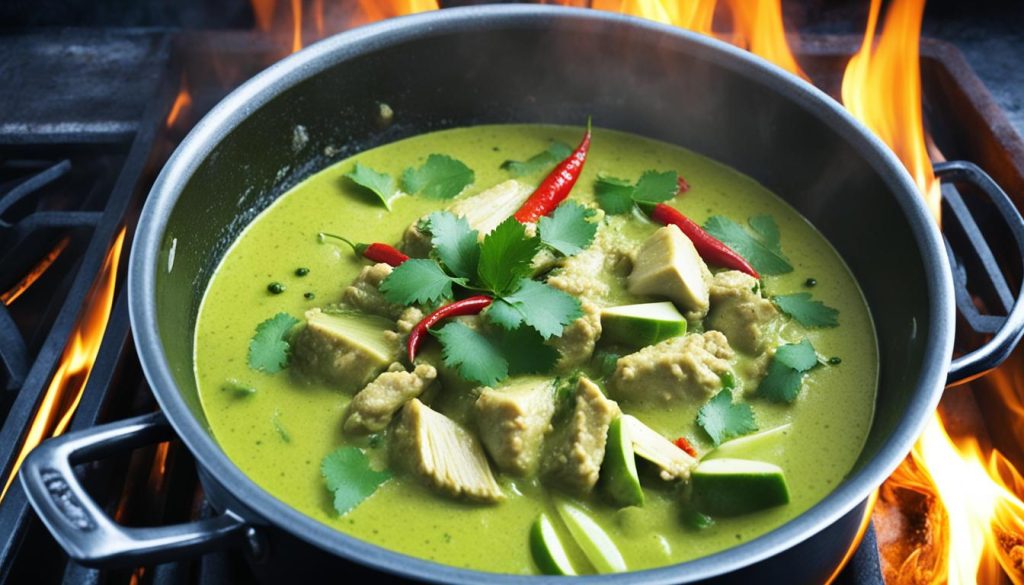
By understanding the heat level of green curry and making adjustments according to your preferences, you can create a delicious and satisfying curry that tantalizes your taste buds.
What is in Green Curry Sauce?
Green curry sauce is made up of a few simple ingredients that come together to create a flavorful and aromatic sauce. The key ingredients in green curry sauce include:
- Green curry paste
- Coconut milk
- Water or broth
- Fish sauce
- Sugar
The green curry paste is the star ingredient, responsible for the vibrant green color and bold flavors of the sauce. It is made from a blend of fresh green chilies, lemongrass, galangal, garlic, shallots, and other herbs and spices. The coconut milk adds a creamy and rich base to the sauce, balancing out the spiciness. Water or broth is used to lighten the curry and create a smoother consistency.
Fish sauce, a staple in Thai cuisine, adds a savory and umami taste to the sauce. It is made from fermented fish and adds depth of flavor. Sugar is used to balance out the flavors and enhance the natural sweetness of the coconut milk.
The specific measurements and ratios of these ingredients may vary slightly depending on the recipe and personal preferences. Some recipes may also include additional ingredients like lime juice, makrut lime leaves, or Thai basil for extra flavor. Adjusting the quantities of these ingredients allows you to customize the taste and spiciness of the green curry sauce to your liking.
Now that you know what goes into green curry sauce, let’s move on to the steps of making this delicious Thai dish.
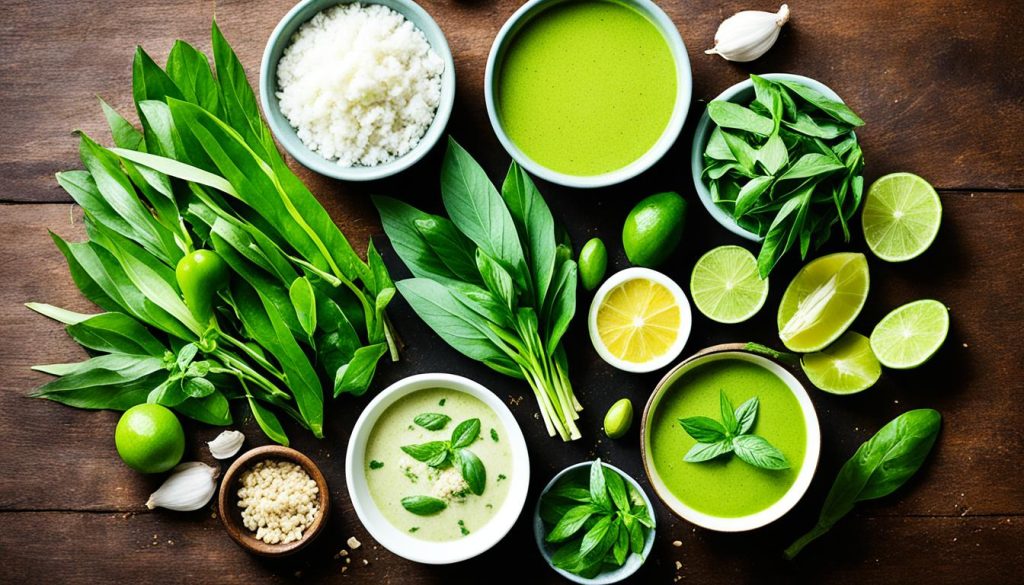
Flavors and Texture of Green Curry
Green curry offers a unique and distinctive taste that sets it apart from other curries. Unlike dry spice-infused curries, the flavors of green curry originate from an array of fresh herbs, giving it a vibrant and one-of-a-kind profile. The use of ingredients such as Thai basil, cilantro, and lime leaves infuse the curry with a burst of freshness that tantalizes the taste buds.
What distinguishes green curry from its Indian counterparts is its lighter and brothier texture, resembling a comforting soup rather than a thick stew. The brothiness of green curry allows the flavors to harmonize and meld together, creating a satisfying and delectable experience.
While Indian curries typically feature a potent curry aroma derived from the use of curry powder, green curry exhibits a subtler aroma that lets the fresh herbs shine through. The fragrance is delicate yet enticing, creating an aromatic journey that enhances the overall curry experience.
Conclusion
Experience the vibrant and authentic flavors of Thai cuisine with this easy Thai green chicken curry recipe. Whether you’re a beginner or a seasoned cook, this homemade green curry is sure to impress with its rich and aromatic taste.
So why wait? Give this easy Thai green chicken curry recipe a try and indulge in a homemade green curry that is both quick and tasty. Unlock the secrets of Thai cuisine in your own kitchen and savor the authentic taste of Thailand.


